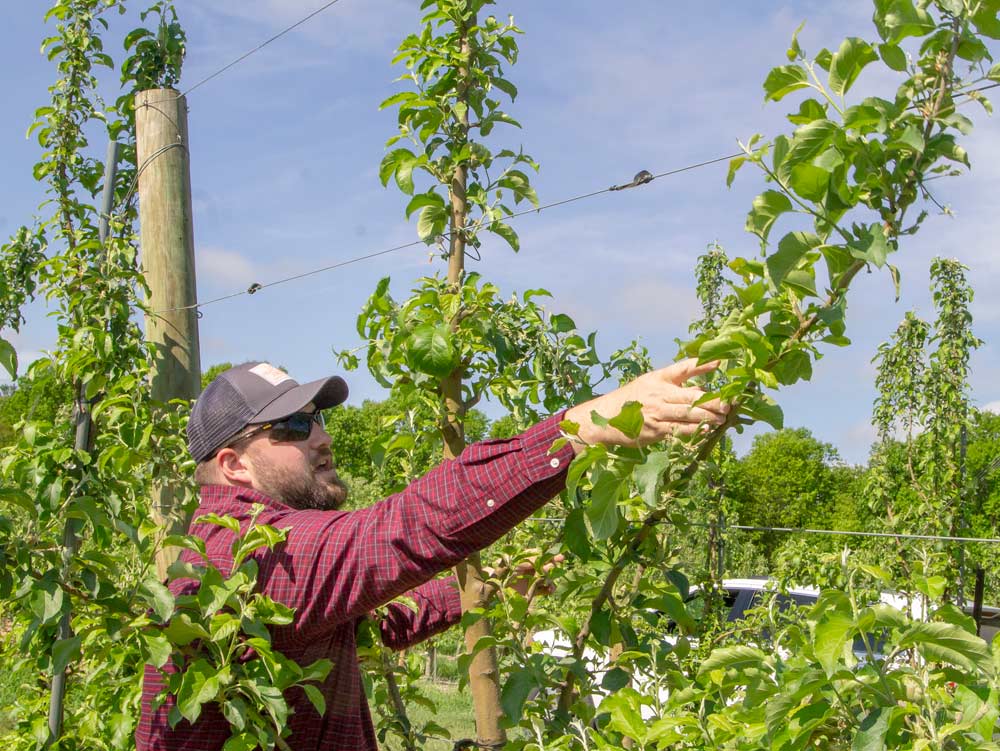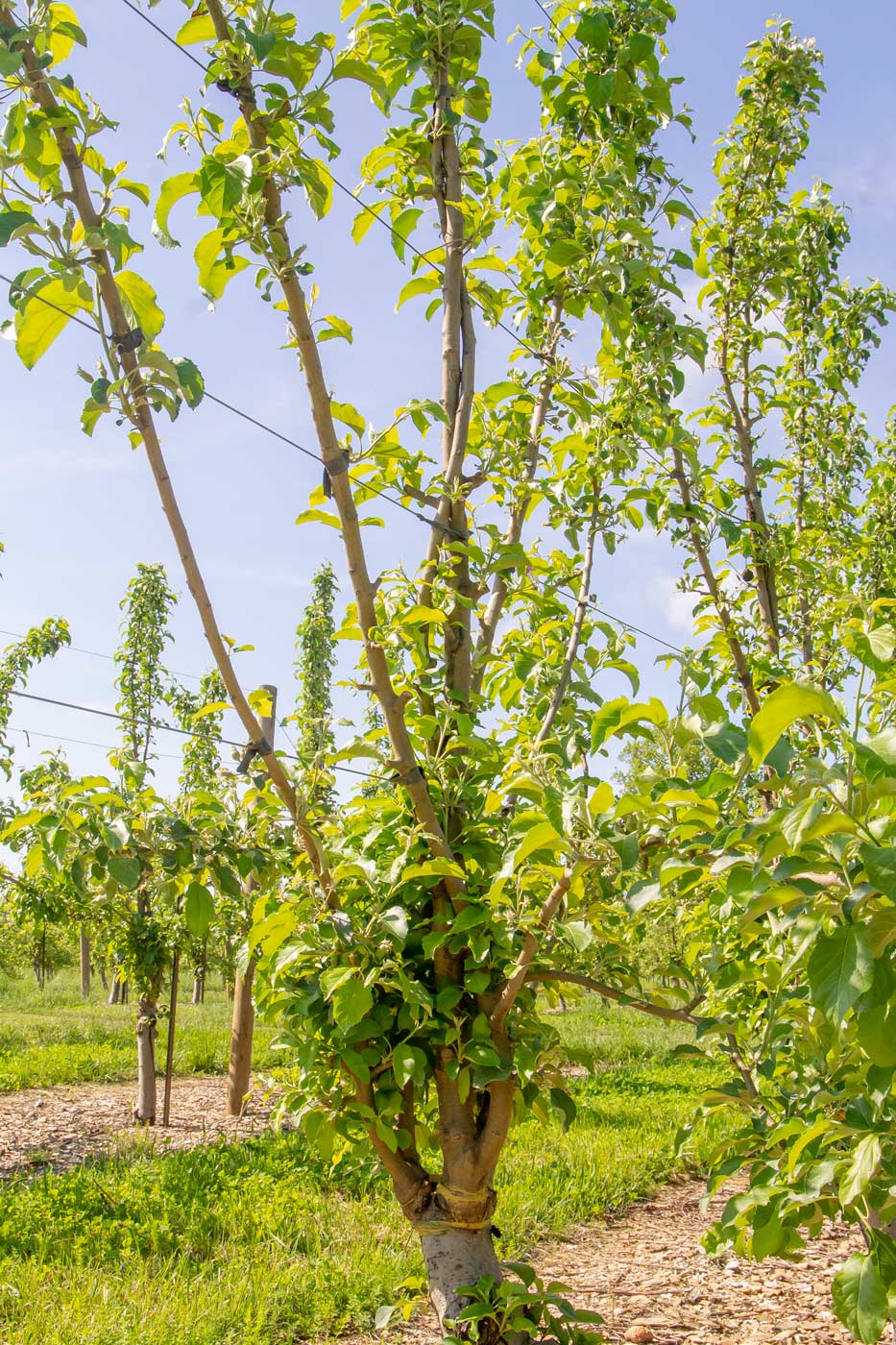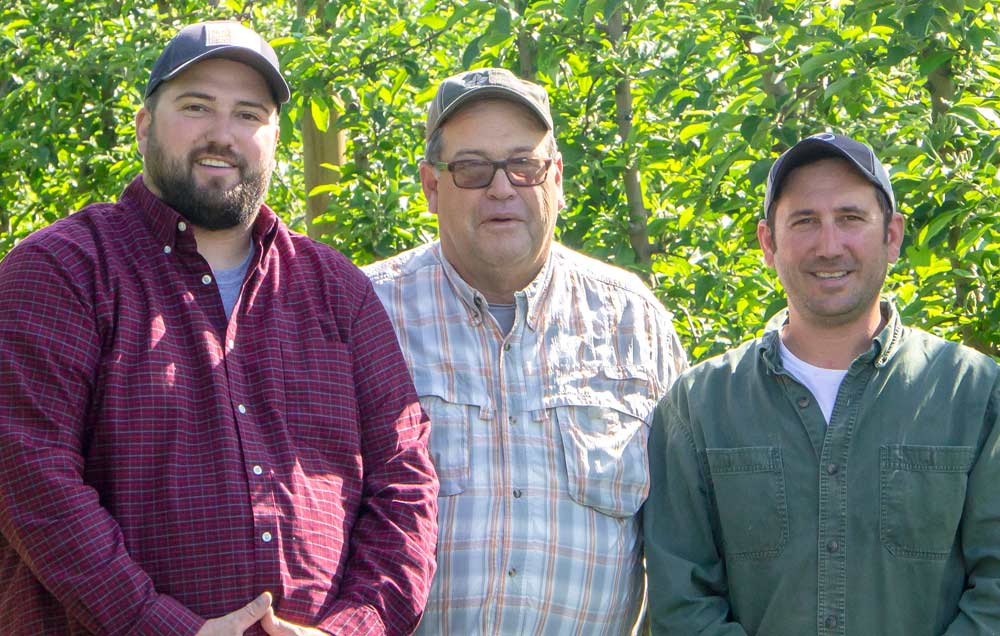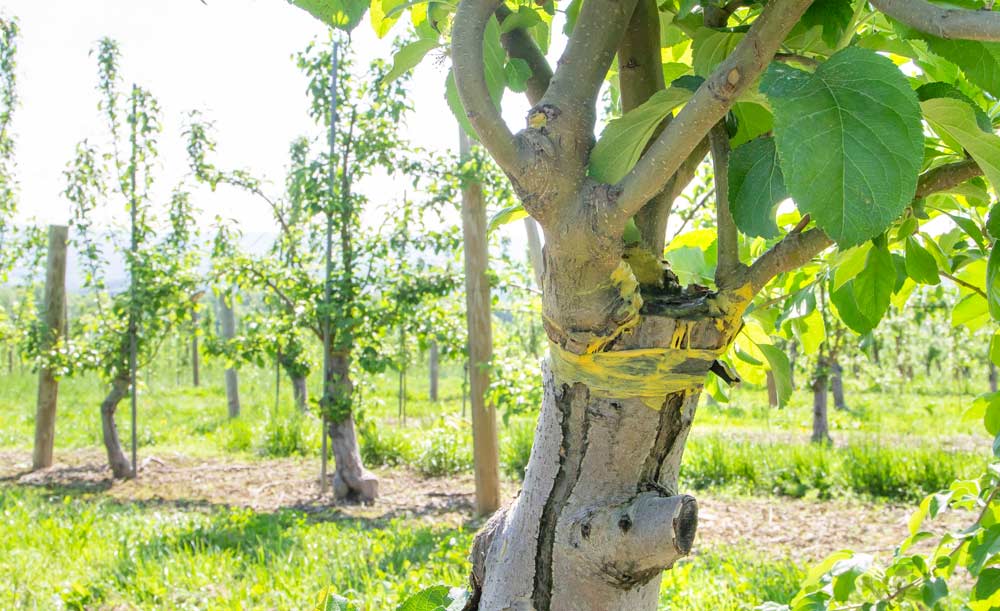
Mark Boyer explains his strategy for training multileader Cripps Pink that was top-worked onto an older Red Delicious block at Ridgetop Orchards. (Kate Prengaman/Good Fruit Grower)
At Ridgetop Orchards in Western Pennsylvania, growers Dan Boyer and his sons, Mark and Seth, are aggressively pursuing the latest fresh market varieties. But cash for new plantings is limited after investing in a new cold storage facility and dealing with hailstorms that hit the orchards the past two seasons.
So they’ve been grafting over old Red Delicious orchards, planted at 5-by-16 feet, to three- or four-leader systems of more desirable varieties.
That creates a fruiting wall-type system with 1,500 “trees” or more per acre, if you count by axis, Mark Boyer said. This year alone, they grafted over 23 acres of Reds with EverCrisp, Wildfire Gala and Royal Red Honeycrisp, he said.
“It was a way to get into the variation we needed around here, but when we didn’t have the money for new plantings,” Mark said.
Not waiting to invest in the varieties for the future is a lesson Mark learned from his father. In the late ’90s, after tariffs were placed on Chinese juice concentrate, Dan Boyer elected not to pay off his debts with the extra income from the boost in juice prices. Instead, he bought and grafted Honeycrisp, Mark said.
“That was really the thing that rejuvenated the orchard,” Mark said. The higher elevation of the family’s 450 acres, nestled in the hills in Bedford County, provides cooler nights that help the high-value fruit get good color, something that has sometimes challenged other Mid-Atlantic growers. “Honeycrisp really changed everything.”

Experiments with multileader Honeycrisp, top-worked over an old Red Delicious block, helped Ridgetop Orchards improve the orchard portfolio when investment money for new plantings was limited, said Mark Boyer of Fishertown, Pennsylvania. (Kate Prengaman/Good Fruit Grower)
When Mark returned to the family business after college a decade ago, it was 70 percent Reds and Goldens, but now Honeycrisp and Gala are the top varieties. Continuing to pursue new fresh market varieties is top priority, but also a budget challenge for this family farm.
Mark got the idea to convert old plantings into multileader systems on the International Fruit Tree Association tour of Italy in 2014 and decided to try it out because, “on a multileader system like this, if you make a mistake, you can grow it back.”
This strategy of grafting over old blocks can be a good way to learn about how to train and prune multileader systems with less risk than investing in new plantings with a new system, said Mario Miranda Sazo, horticulturist for Cornell Cooperative Extension’s Lake Ontario Fruit Program.
It’s an approach that makes sense for Eastern growers who want to increase density but have been challenged to manage the dense, bushy canopies of vigorous trees grown in fertile soils, he wrote in an article for the New York Fruit Quarterly last spring.
“It’s a lot better to move to high-density management through grafting, because you can learn a significant amount about how you are going to manage these canopies,” Miranda Sazo told Good Fruit Grower.
“Some growers who have tried multileader have struggled with the investment. It’s more work than planting at 3-by-12, so for us, it’s a big jump,” he said, referring to the standard new plantings in New York. “Growers can get a flavor of that by grafting old orchards; that’s how to practice going from 1,000 trees per acre to 2,000 trees per acre.”
The benefits of a multileader fruiting wall include simplified canopy structure, more uniform fruit color and size and increased opportunity for mechanized hedging.
Miranda Sazo recommends spacing each leader 18 to 20 inches apart and upgrading to a trellis that has at least five or six wires to support 12-foot or taller leaders. That height takes advantage of the wider in-row spacing of the older block.

Dan Boyer, center, owns Ridgetop Orchards and runs it with his sons, Mark, at left, and Seth, at right. (Kate Prengaman/Good Fruit Grower)
Mark Boyer said he aims to train each leader about 2 feet apart on the trellis, to maximize light exposure and make the most use of the space with three or four leaders per root. There’s still some training to do in a Cripps Pink block in its third leaf, but Mark plans to fully crop it this year.
“I’m trying to do two things at once. I’m trying to grow the tree and to crop it, because I want to try to slow it down,” he said. “Honestly, I don’t care if it works or not. I’ve got nothing to lose if it goes back to a central leader.”
Mixing grafting in with new high-density plantings at 2 feet-by-12 feet is part of a larger risk management strategy for the Boyers — keeping the high-value blocks spread across the 5-mile long orchard.
“We’ve realized how important it is to set your orchard up to get Honeycrisp in different areas, so not all your eggs are in the same basket in case of hail,” he said. •

Grafting over old Red Delicious orchards with newer varieties trained to a multi-leader system increases the fruiting axes per acre dramatically, without the same investment as replanting, Mark Boyer said. (Kate Prengaman/Good Fruit Grower)
Grafting lower
A new method of grafting shows promise for converting old blocks to multileader systems that start closer to the ground and are easier to train, Mario Miranda Sazo said.
“With two or three sticks close to the ground, it’s a new technique that allows us to graft old orchards we were not thinking we could, to now growing two or three leaders per tree to fill the space more quickly,” he said. “It’s more like a multileader system from the nursery.”
Known as “beaver” or “notch” grafting, it uses a deep, angled cut in the trunk below the nursing limbs as the grafting surface. This lower start gives growers a better chance to start spacing the leaders properly, Miranda Sazo said.
He worked with growers Eric and Robert Brown of the Orchard Dale Fruit Co. in Waterport, New York, last year to try it out. Pleased with the performance, the Browns opted to use the technique on more acreage this year and several other New York growers tried it as well.
Traditional top or side grafting often starts at least 2 feet off the ground, based on nurse limb availability, which means the new leaders don’t get well spaced until they are 3 or 4 feet high, creating a tight zone that is challenging to prune, he said. Starting lower creates more uniformity that helps growers manage the multileader system.
—by Kate Prengaman






Leave A Comment